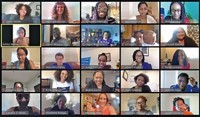Advertisement
Grab your lab coat. Let's get started
Welcome!
Welcome!
Create an account below to get 6 C&EN articles per month, receive newsletters and more - all free.
It seems this is your first time logging in online. Please enter the following information to continue.
As an ACS member you automatically get access to this site. All we need is few more details to create your reading experience.
Not you? Sign in with a different account.
Not you? Sign in with a different account.
ERROR 1
ERROR 1
ERROR 2
ERROR 2
ERROR 2
ERROR 2
ERROR 2
Password and Confirm password must match.
If you have an ACS member number, please enter it here so we can link this account to your membership. (optional)
ERROR 2
ACS values your privacy. By submitting your information, you are gaining access to C&EN and subscribing to our weekly newsletter. We use the information you provide to make your reading experience better, and we will never sell your data to third party members.
Profiles
Movers And Shakers
Jaime Irick, a PPG executive, on the chemical industry’s response to racism and discrimination
Head of the firm’s US and Canada architectural coatings division argues for clear direction from the top
by Craig Bettenhausen
September 12, 2020
| A version of this story appeared in
Volume 98, Issue 35

Vitals
▸ Birthplace: The Bronx, New York
▸ Age: 46
▸ Studies: BS, systems engineering, US Military Academy at West Point, 1996; MBA, Harvard Business School, 2003.
▸ Career path: General Electric, 2003–16; Life Fitness division of Brunswick, 2017–19; PPG Industries, 2019–
▸ Family: Wife, Myah; children, Fiona (6), Aiden (4), Quinn (2)
▸ Favorite molecule: H2O
▸ Hobbies: Reading biographies, watching my children practice tae kwon do
“In a racist society, it’s not enough to be non-racist, we must be anti-racist.” That quote from civil rights activist Angela Davis might not be what you’d expect in a memo from a vice president at a major paints and coatings company. But that was one of several strong messages in Jaime Irick’s email to the 6,000 employees he leads as PPG Industries’ vice president for architectural coatings in the US and Canada, which he sent just after the killing of George Floyd by Minneapolis police.
For Irick, it’s personal and professional. The son of a Black father and white mother, Irick says he “grew up with both of my parents recounting stories of their experiences demonstrating and standing up against injustice.” His parents’ marriage in the 1960s was illegal in parts of the US, and they were heavily involved in the civil rights movement.
But in addition to being the right thing to do, being anti-racist, diverse, and inclusive strengthens a company—especially one that’s reliant on chemical and engineering innovation, Irick argues.
He says he’s not acting alone. In PPG’s second-quarter earnings call on July 17, CEO Michael McGarry focused on racism and discrimination before turning to finances. “As a society, we’re at a pivotal moment in history, and clearly, enough is enough,” he said.
McGarry, Irick, Chief Technology Officer David Bem, and other PPG leaders have since led all-staff calls, panel discussions, and small-group sessions on racism and other forms of discrimination in the workplace. All managers are completing workshops on identifying and combating unconscious bias.
C&EN spoke with Irick about what this moment in American history means for PPG and the broader science business community. This interview has been edited for length and clarity.
What’s the difference between diversity and anti-racism, and what does the distinction mean in a science and engineering company?
Diversity, equity, and inclusion are incredibly important. But at the same time, if you just use diversity and inclusion, you miss what’s happening: there’s a disproportionately high level of racism, violence, and discrimination against Black Americans.
So if you don’t call it out, my view is you’re apathetic. You can’t claim ignorance. It’s just apathy. And I’m really proud of the fact that PPG, starting with our chairman and CEO and our board, is calling it out.
First, I think you’ve got to get to a general level of understanding, awareness, and empathy. I think the vast majority of us have good intentions but low to mid awareness as it relates to racism, discrimination, and bias. We’re not bad people; we’re not going out trying to harm others. We’re not the cop in Minneapolis who killed George Floyd with a knee on his neck for 8 minutes and 46 seconds. The majority of people have good-enough intentions but may not have had experiences with diverse people, whether it’s gender diversity or race.
I’ve been leading teams for a few decades. Leaders have to do the stuff that’s difficult. And it’s difficult, it’s uncomfortable talking about race in the workplace. We need to give people space to be imperfect with these dialogues. And we, as the African American community, need to support our white colleagues that are having these—in some cases—first-time conversations on race, racism, discrimination, and bias.
The point of Black Lives Matter isn’t to suggest that Black lives should be or are more important than all other lives. There’s a cartoon by the artist Kris Straub that does such a nice job of putting this into perspective. On a street of homes, if one house is on fire, when the firefighters arrive, they’re going to focus all of their efforts on the house that’s ablaze. And of course all of the other houses on the street, and the people in them, matter. But you need to put out the damn house that’s on fire.
PPG is a paint and coatings company. It could probably get away with being fairly passive. Why does an active stance make sense for the firm?
First of all, the evidence is overwhelming: diverse teams perform better. Empirically, it’s been proven. You can pull up McKinsey research, Harvard Business School research. Any team that wants to perform, especially a publicly traded company like PPG, it’s not just the right thing to do; it’s not a nice to have—it’s critical to performance and outperformance.
That’s why it’s relevant all the time. But it hasn’t been at the forefront all the time.
To not embrace the reality of what’s happening in the country is a failure of leadership, in my opinion. And I love the fact that you’re seeing Michael McGarry and other corporate senior executives here at PPG having these dialogues and beginning to call out things that we can do to improve. PPG is an industrial manufacturing company that has been around for 137 years. It’s incredibly inspiring to see us take a public stance. There’s no time like the present to transform and to change.
Scientists have a reputation for keeping to themselves. How do you bring somebody into this conversation who has good intentions but low awareness and maybe little interest in awareness?
If you work for me—and we’ve heard this from Michael as well—we have zero tolerance for racism, and we also have acknowledged that we are not all as aware as we need to be. In my business, we’ve had discussions about this with all of our employees. If you’re a leader or employee at PPG, this isn’t an opt-in type of thing. There’s an expectation that you participate. There’s an expectation that you share questions, stories—constructive criticism and challenging perspectives as well.
David Bem, our chief technology officer, has been leading from the front here. The science and technology organization actually kicked off their unconscious-bias training last year. They also had a discussion on race and discrimination—a panel that David hosted for his global employee base, who are engineers across the company.
A big part of engineering is problem solving, and a big part of problem solving is bringing different perspectives to old ways of solving problems. Diverse teams are incredibly well equipped to do that. So I’d say it’s acutely relevant to that community.
What can the scientific community do to make the talent pipeline more accessible and less leaky for people of color?
I think there’s a more active role with STEM (science, technology, engineering, and mathematics) education that we can play as corporations, whether that’s at the high school level or beyond, in mentorship programs.
But I also think, for companies, we have to be careful with this narrative. You can make a macro statement; you can say there are fewer Black, Hispanic, and Native American STEM students who graduate than white students. That’s a fact.
However, at a company that may hire, say, 30 engineers in a given year, it is unrealistic to say that you can’t find 10 or 15 or 30, if you choose to, who are diverse. I’m not sure the argument holds up when you’re talking on a micro level for companies.
Once diverse employees get into companies, it’s not as straightforward as the hiring and recruiting process. Then you really have to look at the environment that your employees are working in and make sure you’re creating an environment where everyone feels they can be successful.
You need to build an awareness of unconscious bias and then operationalize around mentorship, sponsorship, and support groups, to help make sure you don’t lose those employees early in their careers. That’s a lot harder. In general, companies have done a better job getting people in the door than getting people up through the ranks.
One specific thing that I’ve seen work is having strong affinity-group networks. They create an environment where you can get professional development that is specific to the experiences that you may have. Like many organizations, we have a minority leadership council. We have a women’s leadership council. Those affinity groups make a company stronger. They help with retention and help the broader community within a company get to know diverse talent.
I’ll give you an example. At GE, I ran my first business unit when I was 32. Leading up to that, I had gotten to know one of the vice chairmen, a gentleman named Lloyd Trotter, because I volunteered within the African American forum. He got to know me, and he got to know the work I was doing in my day job. When the position came open, he put my name forward and said, “Hey, this is a leader that we should interview for this job,” and I was on the slate. If you have strong affinity groups, it actually makes the company stronger on many levels, but one way is visibility into talent within that group that the company may or may not have all the time.
What do you think is going to happen as we go forward from this Black Lives Matter moment, especially in science and engineering companies like PPG?
The jury is still out for what happens in the world and in the US as a result of what I’d call an awakening, a rude awakening, over the past few months.
I have worked at three different corporations over the past 20-plus years, and where I’ve seen senior leadership get behind initiatives and opportunities, more often than not you see progress. To have Michael take such a strong leadership role in the dialogue, the discussion, the learning, and also beginning to map out the actions, I feel very confident we’ll be able to move the needle.
Now, I run a multibillion-dollar business with 6,000 people. So I’ve got a platform within the company and encouragement from the senior leadership to drive this in the business that I lead. That’s going to happen. For the broader company, we’ve got to now put our money where our mouth is; I’m very confident that we’ll continue to do that, given what I’ve seen since I’ve been here.





Join the conversation
Contact the reporter
Submit a Letter to the Editor for publication
Engage with us on Twitter